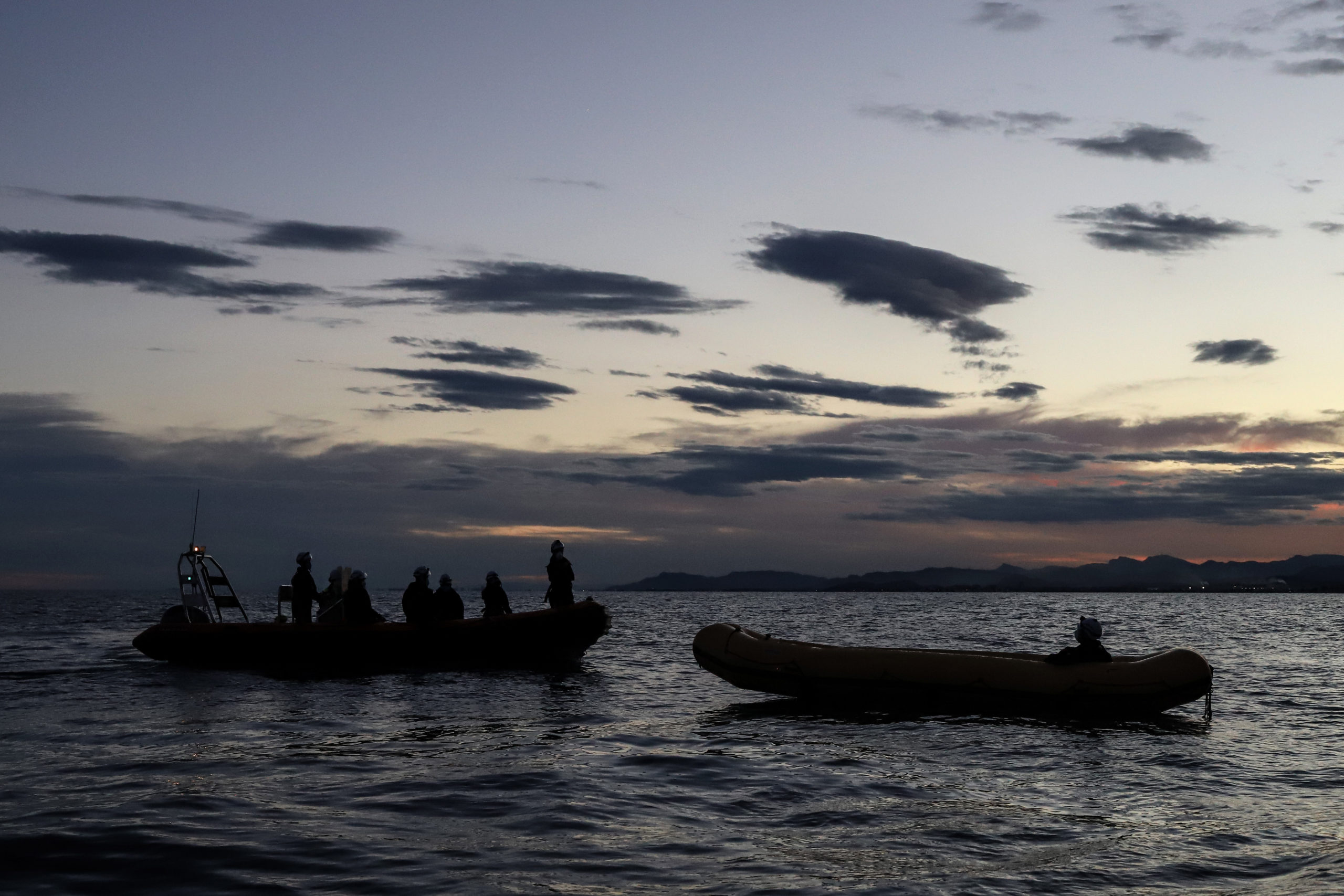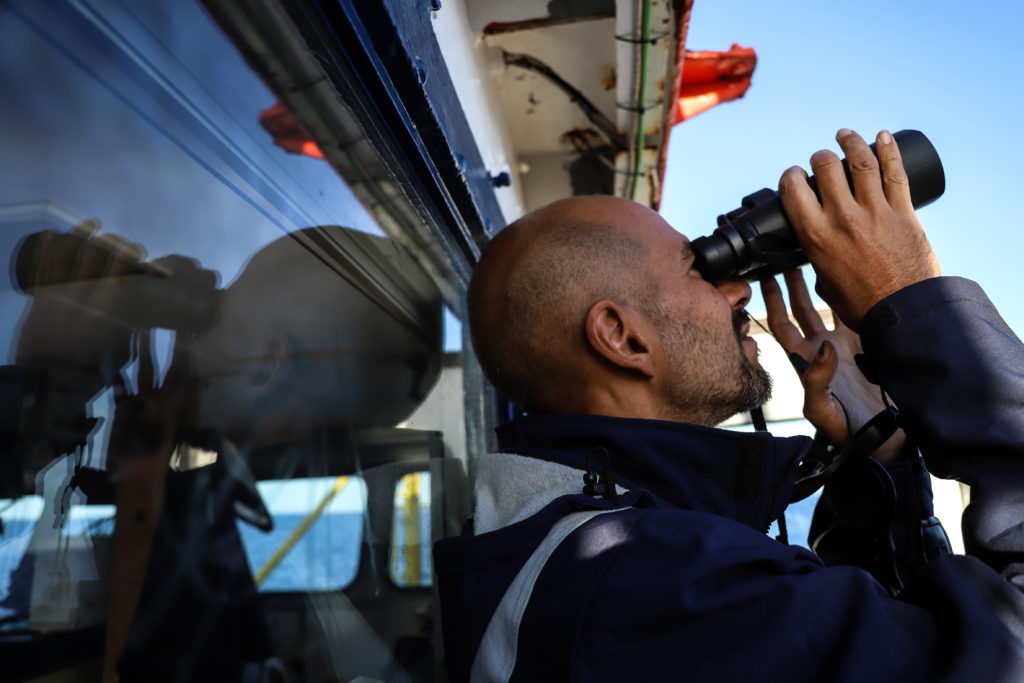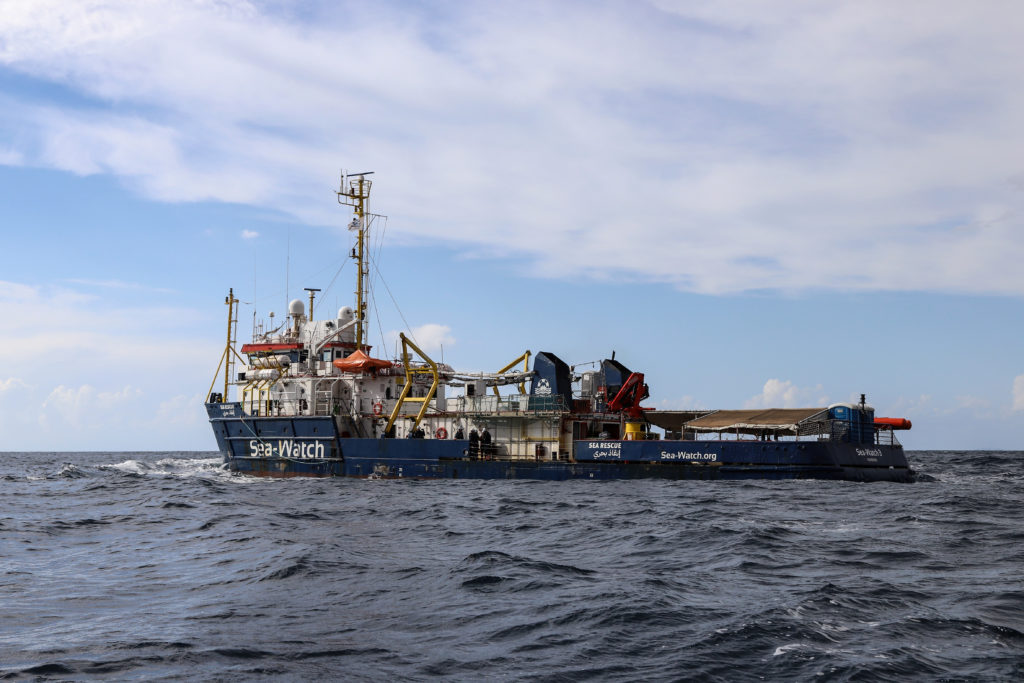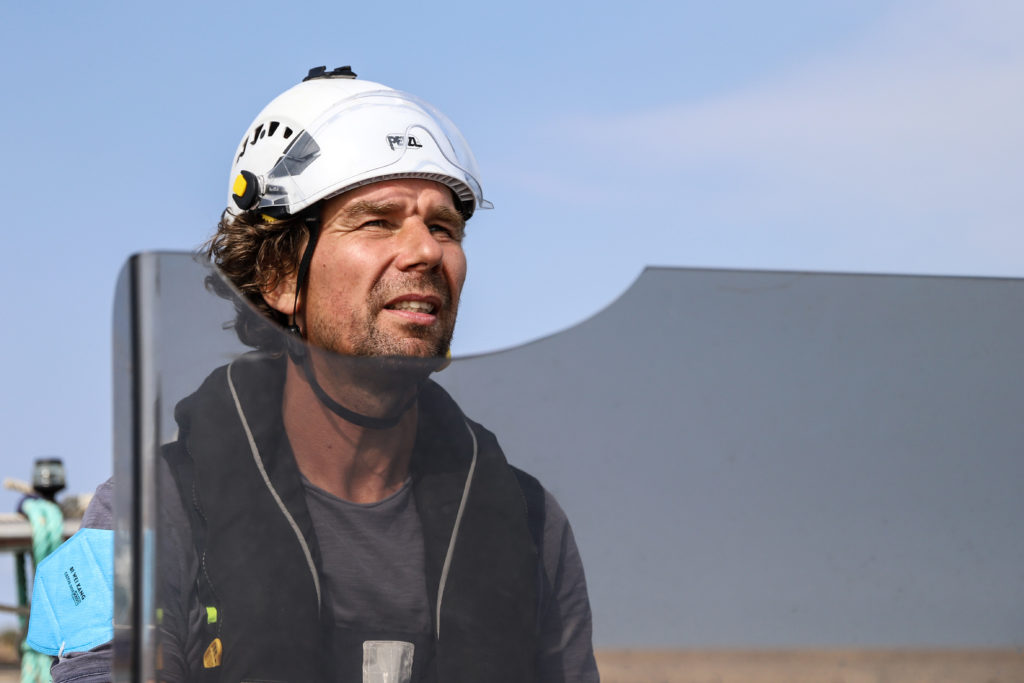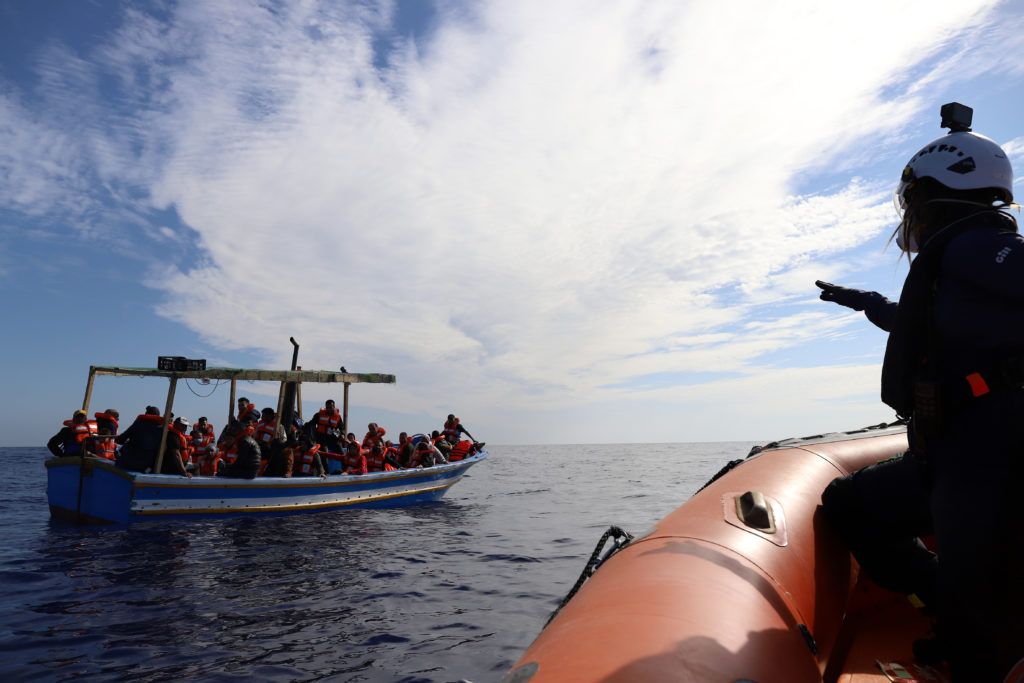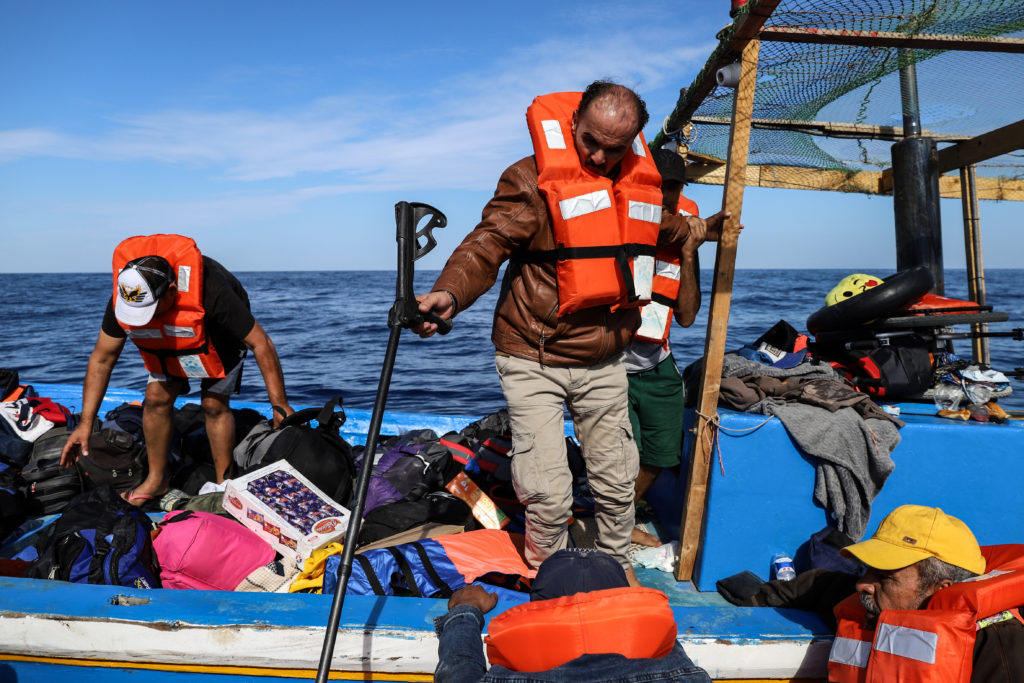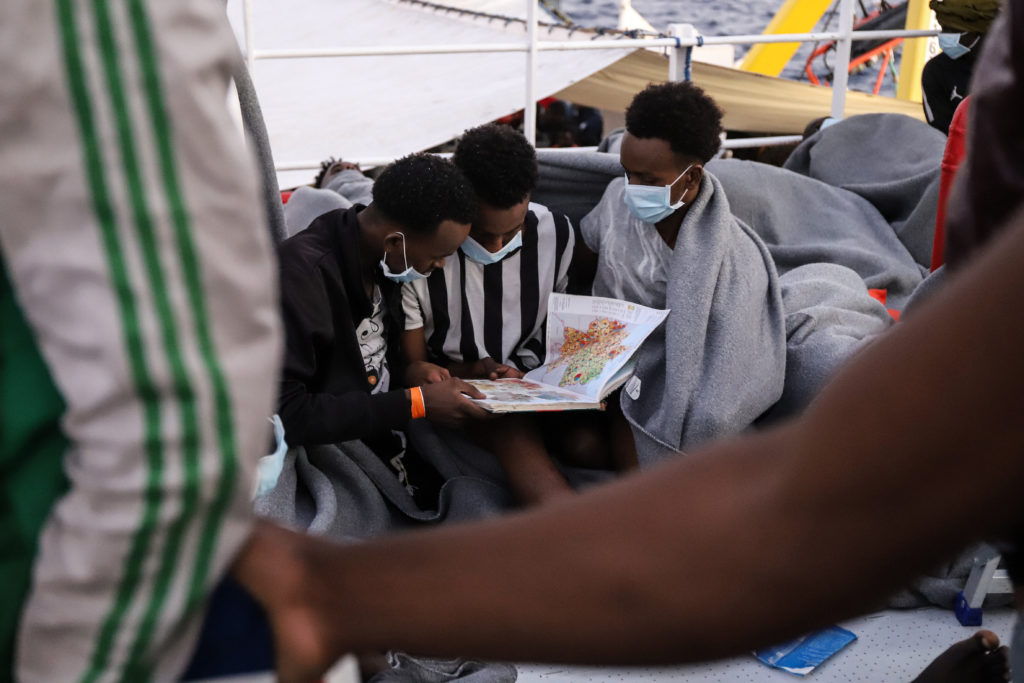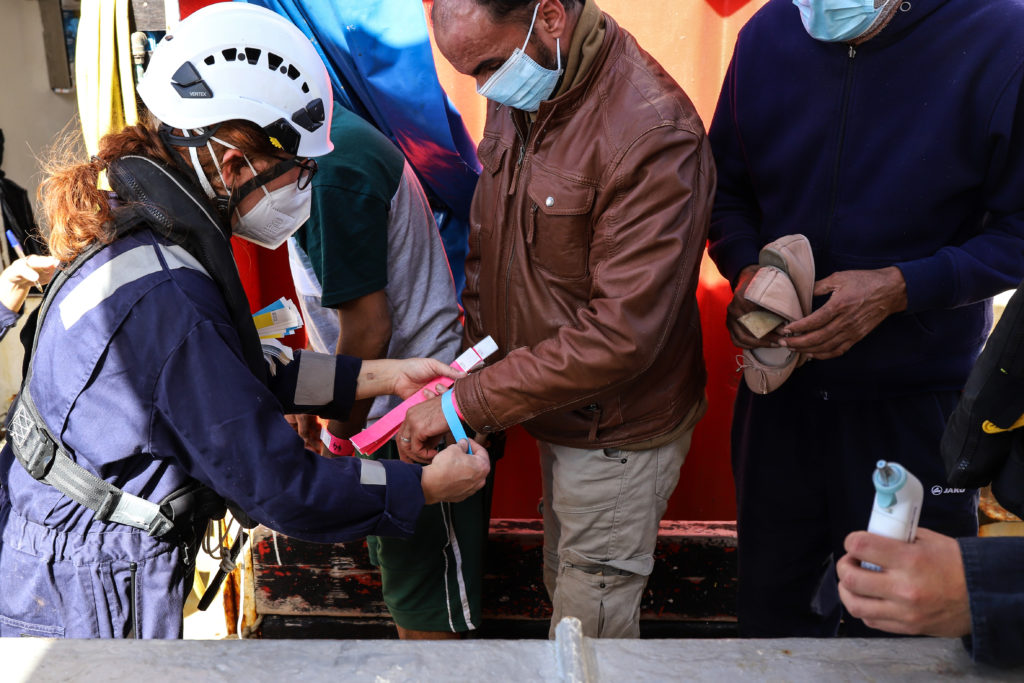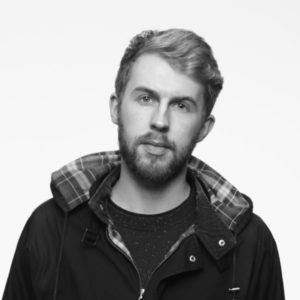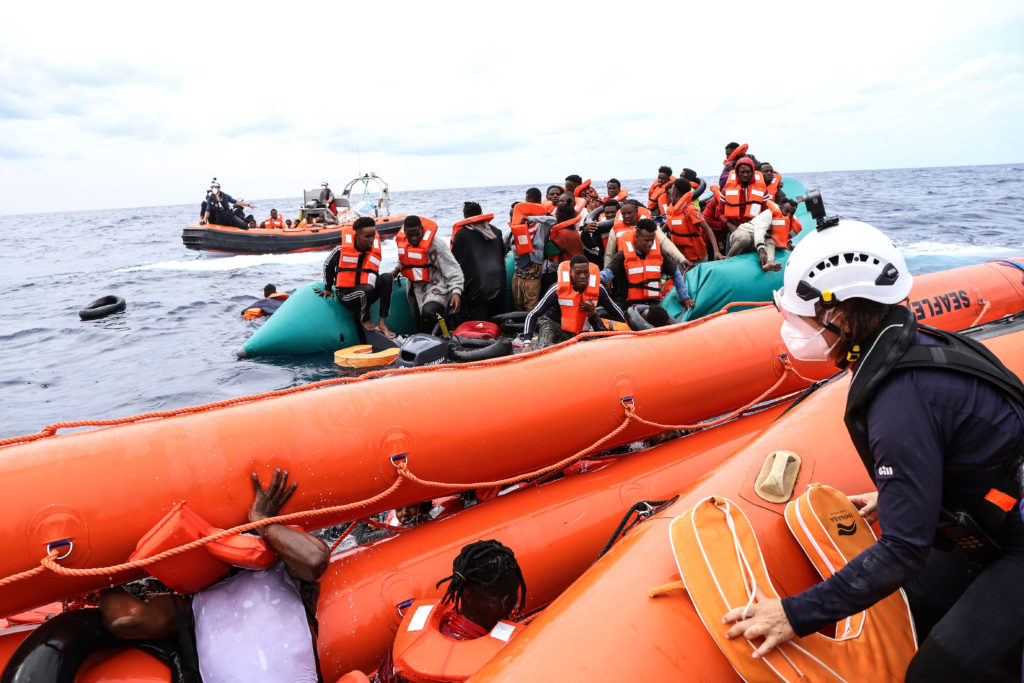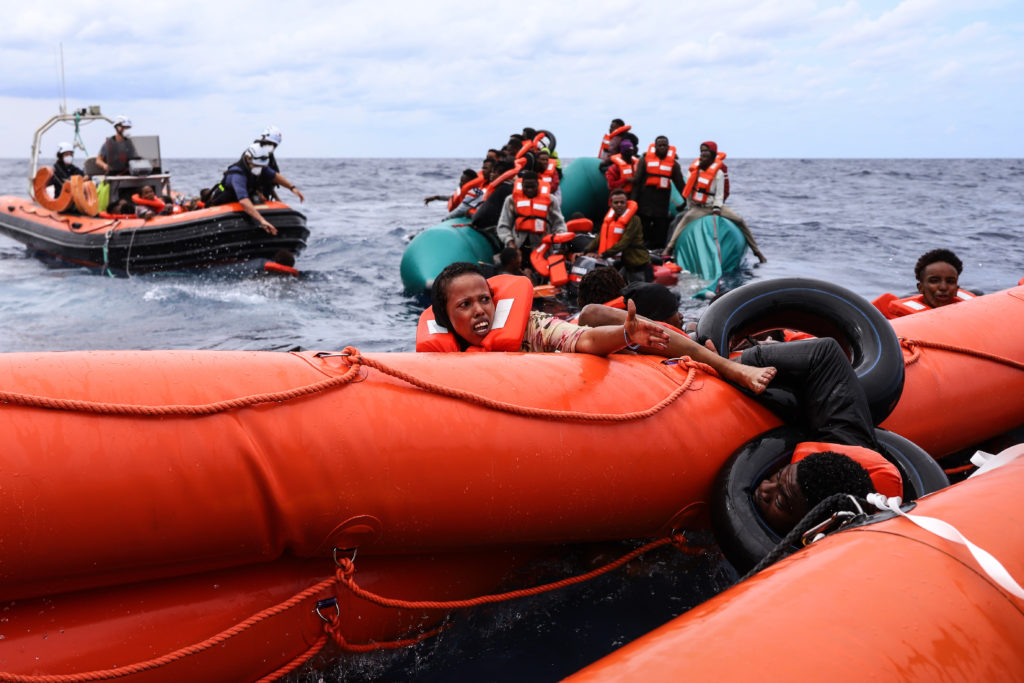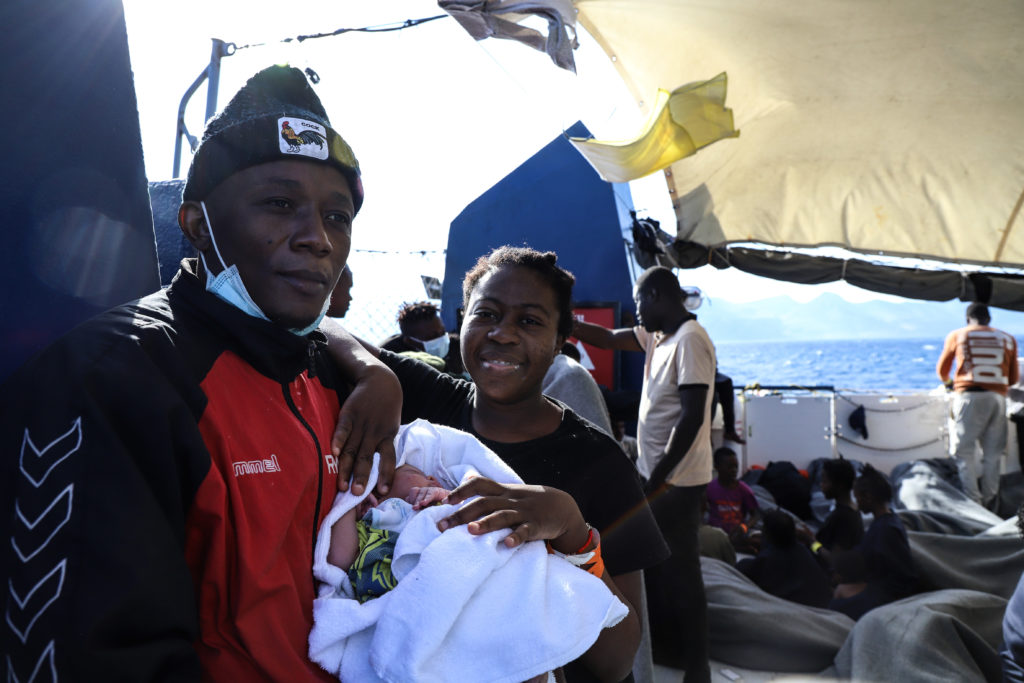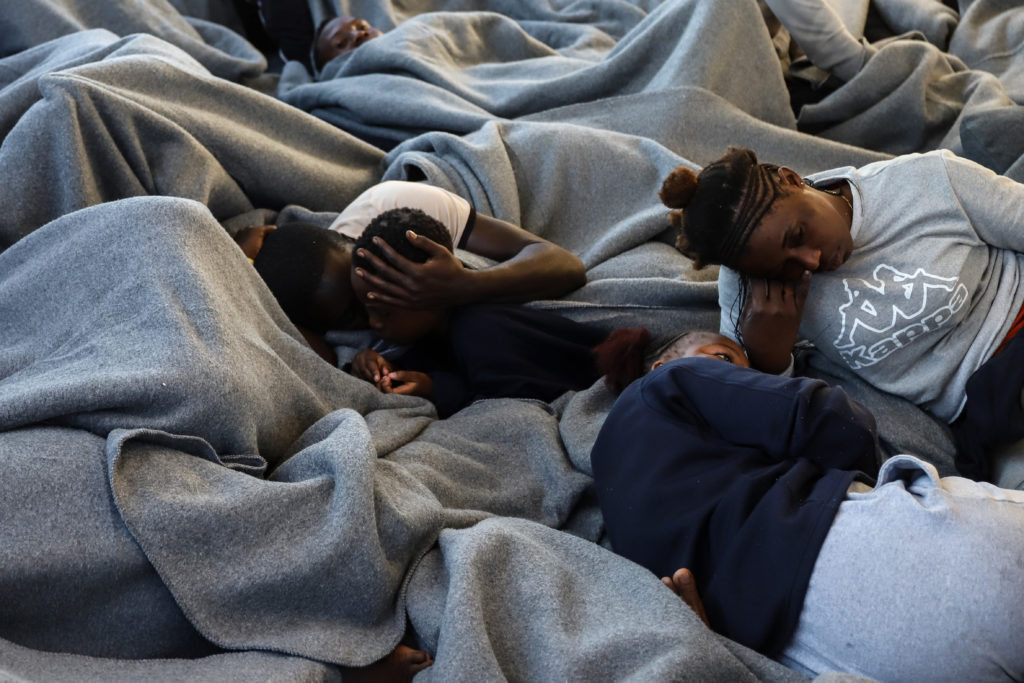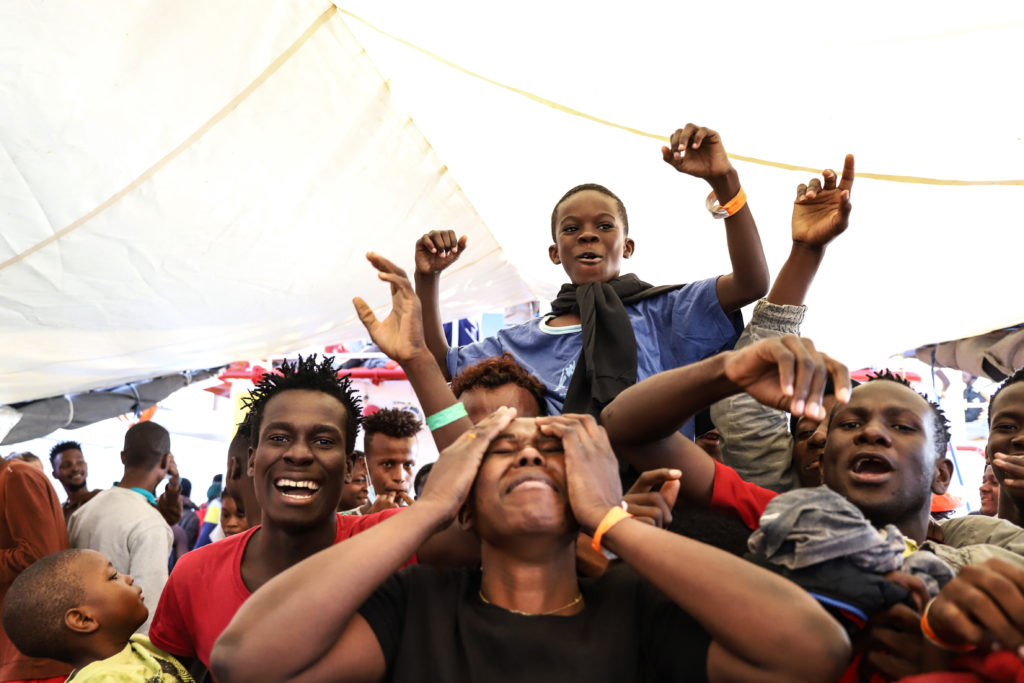Between the 17 and 18 October 2021 the humanitarian ship Sea-Watch 3 rescued 412 people from seven different vessels that had come into difficulty in the Central Mediterranean, within striking distance of the Libyan coast. Rob, a veteran activist, was driving one of the rescue boats. From threats by the Libyan Coast Guard to the practicalities of hosting hundreds of people on a small ship exposed to the elements, he and the rest of the crew faced many challenges in their mission to help migrants reach a safe port in Europe. This is an account of five days out in the open water, saving human lives.
It’s a clear October morning, the sun has only just risen but the Sea-Watch 3 team is already on the move. They need to get the rescue boats ready and head out to sea. The ship’s radar has just picked-up a distress signal from a nearby vessel with around 66 migrants on board. Rob is in charge of one of the emergency dinghies. He keeps calm as he prepares the equipment and gives a few, precise instructions to his team. Everyone puts on waterproofs, lifejackets, a helmet and FFP2 mask. They need to hurry: the Libyan Coast Guard could arrive at any moment. It’s the 17 October 2021 and Sea-Watch 3 is in that country’s search and rescue area, between Tripoli and Sabrata, around 30 nautical miles off the North African coast.
In a few short minutes the crew is ready and the rescue boats are lowered into the water together with two enormous bags full of life-jackets of all sizes, including a few for new-born children. Rob starts-up the motor and quickly leaves the mothership behind.
The rescue team is comprised of eight people; four per boat. Rob, a bright-eyed, 46-year-old Dutchman with sailor’s wrinkles, is driving the Alpha boat. He’s got a wife and three children back home. Since joining the Sea-Watch team in 2018 Rob has taken part in three missions. He quit his stable job with a Dutch TV company to volunteer in the Mediterranean after experiencing a serious burnout. “I had to start doing something I really believed in,” he recalls.
The vessel in difficulty is a wooden ship, and it’s packed full. There are lots of old people, women and children on board. As soon as the migrants see the rescuers approaching they get excited and everyone starts waving for help. The team on Rezai, the first rescue boat, make the initial approach; Rob’s team, on Alpha, stay a few metres back to survey the scene and make sure that everything goes okay.
“We’re part of a humanitarian organisation,” says Niko, the cultural mediator aboard Rezai. “We’re here to help you.” Niko is careful to establish contact in an assertive but reassuring manner. It’s essential that everyone remains calm for the operation to succeed. Because there are, in fact, many things that could go wrong: first of all, there’s the risk that someone might jump in the water to reach the lifeboats. This is also why Sea-Watch 3 keeps well-away from the rescue area: if it were too close, some people might be tempted to try and swim directly to the mothership.
“Keep an eye on the horizon”
After demonstrating how to put them on correctly, Niko hands the lifejackets over to the migrants. Then people start to be boarded onto the Rezai. There are a few moments of chaos as people push and shove one another. They all want to be the first to get inside. Niko has to raise his voice: “Women first!”, followed by their children (so there’s someone ready to pick them up).
In the meantime, Alpha remains back so the team can check the surroundings. “Keep an eye on the horizon,” Rob says to Lena, another member of the crew. They’re afraid that the Libyan Coast Guard’s grey patrol boat could arrive at any minute. Protocol maintains that if it and an NGO ship reach a vessel-in-difficulty at the same time – while within the North African country’s search and rescue zone – the national authorities have precedence and can take the migrants to Libya. To make matters worse, the Coast Guard has frequently threatened NGOs that work in the Central Mediterranean. In July 2021, for example, the Libyans shot in the direction of a migrant boat, in an attempt to stop it crossing towards Europe. The Sea-Watch crew caught the incident on camera.
Once it’s full, Rezai turns back to the mothership. Now it’s Alpha’s turn to approach and pick-up the migrants. One woman falls ill while getting into the boat. She has to be helped to sit down. An old man with a crutch struggles to drag himself aboard. Another cannot walk so he has to be hauled-up along with his wheelchair. Rob is repeatedly forced to shout for silence to maintain order on board.
Manoeuvring the rescue boat towards the mothership is always a complex task. The Sea-Watch 3 is a cargo vessel, and it’s very heavy. When it moves back and forth it creates enormous waves that rock the Alpha. There’s a real danger that someone could lose their balance and fall into the water, potentially being sucked into the ship’s engine. Rob therefore has to make sure that the rescue boat follows the exact movement of both the Sea-Watch 3 and the waves. As soon as he feels an upward swell he shouts “Now!” This is the signal for the first migrant on the dinghy to be passed safely into the arms of the crew aboard the mothership. The rescued woman falls to the floor of Sea-Watch 3. As soon as she gets up, her baby is passed immediately into her arms.
No respite
Once they’re all safely on Sea-Watch 3 the migrants need to be searched for weapons, cigarettes or lighters. A fire is the greatest risk on board. Next the migrants have their temperatures taken, they’re given a face mask and a paper bracelet is tied to their wrist: yellow for unaccompanied minors, red for medical emergencies and so on. The migrants wait patiently in line. In the meantime, people offer their thanks to the crew. Everyone is allocated a blanket and a small bottle of water. Most get settled on the deck. Only the most fragile women and children are permitted to sleep inside, in a small room of just a few square metres, which is overcrowded in no time at all.
Suddenly a Libyan Coast Guard patrol boat appears on the horizon and approaches the migrants’ old vessel. Fortunately it’s now empty.
About an hour later, Alpha and Rezai have to head out to sea once again: another vessel is in difficulty. The second rescue proceeds much like the first, and the Sea-Watch 3 starts to fill-up. There are now 120 migrants on-board; already a significant number for a crew of 22. Things start to get chaotic. People need their basic needs met: dozens need to be fed, and some require medical assistance. Just to give an idea: it takes several hours simply to prepare some tea and do the washing up.
Many of the migrants from the first boat are Libyans who have only just left their country, so they’re used to home comforts. The migrants from the second boat, meanwhile, have mainly come from Sub-Saharan Africa. They’ve been travelling for months; some of them for years. Many have escaped from Libyan detention centres. For those on the second boat, the nightmare has just come to an end. For those on the first, it has just begun. Some of the Sub-Saharan Africans start hassling the Libyans and tensions begin to brew. “Not all Libyans are evil people” intervenes Sophie, one of the crew members.
Sophie’s job is to coordinate the reception operations: including preparing tea and meals. When one mother asks for “some milk for the baby” another four immediately want bottles for their own children. Meanwhile, the three doctors-on-board spend hours treating the most severely afflicted: many people, women in particular, are suffering from painful and debilitating fuel burns. To protect themselves from bad weather they often sit at the bottom of the deck. The problem is that when the migrants are forced to remain onboard for days on end they have no other place to excrete their bodily waste, so it’s here, in that exact spot, that a highly corrosive mixture of petrol, faeces and urine is deposited.
On Lesbos solidarity turned into anger
The Greek island of Lesbos is the place to start if we want to see how Europe’s stance towards incoming refugees has hardened in recent years. In 2015, as Europe declared a refugee crisis, around a million people landed on Lesbos.
Despite Greece struggling to navigate a crushing economic crisis, local people joined with international volunteers to save lives at sea, support the new arrivals and help refugees in their onward journeys to western Europe. Lesbos was praised internationally and islanders received the inaugural John McCain award “for their heroic support of refugees fleeing mayhem throughout the Middle East and Africa.”
But in 2022, the picture couldn’t be more different. You can see this shift in the eyes of the exhausted locals and in the guard towers and barbed wire fences that have sprung up to contain the thousands unlucky enough to be stuck in Lesbos’ new closed camp today. Arrivals have slowed to a trickle but authorities are still on guard against a possible influx from Afghanistan.
Many locals who volunteered their time to help in 2015 have since joined protests calling for the government to keep refugees off Lesbos. The ferocity of this protest movement peaked in early 2020, when NGO volunteers had their cars smashed, reception centres were burned, journalists were beaten and riot police were called in. Only a small minority supported the violence but almost everyone on the island agrees: this situation can’t go on any longer. Some locals just want to keep refugees out while others have called for a coherent humanitarian solution that gives refugees safe and legal routes to claim asylum, while relieving the pressure from points of entry, such as Lesbos.
The Greek government, with support and funding from the EU, has opted for a militarised response: building the walls of Fortress Europe ever higher and exporting border enforcement to states with poor human rights records, such as Turkey and Libya. When an EU interpreter documented his expulsion to Turkey in late 2021, it became impossible to ignore what NGOs have long claimed: men in black balaclavas without insignia are increasingly conducting illegal pushbacks at sea and near the Evros river, Greece’s land border with Turkey.
As Ursula von der Leyen, President of the European Commission, said in March 2020, on a visit to the Greek-Turkish border, Greece is “Europe’s shield.” Translation: just keep people out – by any means necessary – and we’ll look the other way.
The next day, on 18 October, towards six’o clock in the morning, the captain of the rescue crew knocks along the cabin doors. The sun hasn’t risen yet, but it’s already time to head out to sea. There’s a vessel in difficulty nearby, the first of four that Sea-Watch 3 will assist before the day is up. Once again, in just a few minutes, everyone is ready (getting securely dressed as fast as possible is one of the many skills that are taught during the training on dry land).
As usual, Rob is ready before the others. He’s taken part in a lot of missions by now. Yet this one is special. In October 2016, while he was loading migrants onto the rescue boat during his first volunteer experience for a small NGO, someone passed him a bundle. Rob assumed the object was luggage and he was ready to chuck it into the water as an example to others. After all, space on the rescue boat is limited. Lives are saved first, then bags. But a second before throwing the bundle away Rob realised that there was a new-born child inside it, just four days old. Sarah. “That rescue changed my life,” Rob says. Five years on he doesn’t know what happened to the little girl, let alone her mother. But to celebrate the anniversary of that meeting Rob is recording a podcast during this mission, in collaboration with a Dutch journalist. Before lowering himself towards the sea he therefore inserts a small microphone into his pocket, wrapped in a plastic bag to protect it from the water.
The crew gets aboard the rubber rescue boats. On Rob’s instructions, Alpha also brings a CentiFloat along; a kind of long tube-like life-saving float which on account of its bulky size prevents the boat from gaining speed (it can therefore be an obstacle to reaching a far-off vessel or quickly escaping the Libyan Coast Guard). Yet it will prove essential shortly after.
Safe, by a hair's breadth
The first three rescues are completed one after the other, without any hitches. It’s during the fourth, however, towards one in the afternoon, that the situation gets trickier: the makeshift craft that Alpha and Rezai approach is overflowing with human beings. Worse still, the hull has been punctured. One of the migrants covers the hole the best they can, with a hand and a foot, but it’s useless and the inevitable soon happens: the boat deflates. In a split-second dozens of migrants end up in the sea. Rob and his team manage to throw the CentiFloat into the water just in time for the migrants’ to grab hold of it with frozen, panicked hands. A young woman screams out in terror.
Rob coordinates the ‘rescue within the rescue.’ First, the weakest have to be saved; those who are making the least noise. “If you still have strength to scream”, he remarks later on, “it means you’ve also got the energy to survive.” At one point he’s forced to shut down the boat’s engine because Alpha is surrounded by people. The rescued who are strong enough are asked to pull the others – still clinging to the CentiFloat – out of the water. Somehow or other, all the migrants manage to get into the rescue boat. The operation only took a few minutes, but, for everyone involved, it felt like hours.
Some of the migrants cry, some laugh and others pay their thanks to God. A young couple, amazed to be safe, hug one another. Rob asks if everyone is accounted for. “I thought that among the bags and the clothes in the water we would find someone,” he comments later on. “I know what a person face down in water looks like.” He continues to ask, insistently, if anyone has lost a friend or a family member.
This is indeed one of the most tragic aspects of the deaths at sea: the numbers are never certain. In 2021, for example, 2,041 people were declared dead or missing in the Mediterranean (source: Missing Migrants Project – OIM/IOM). From 2014 to present the total of missing people is 23,355 but the number could be much higher. If no one reports a disappearance, or if a body, a piece of it, or an identity document aren’t found, the death never officially occurs. That person simply stops existing. This time, though, everyone’s safe. “It was a blessing, or just good luck,” declares Rob.
An endless wait
By now there are 412 migrants on board Sea-Watch 3. In other words, the boat is overcrowded. So much so that the new arrivals have to be settled on the highest deck, which is exposed to bad weather. Luckily it will only rain for one night, a few days later. Nevertheless, the coming hours will still prove a terrible ordeal, both for the migrants and for the crew on duty. The wind is freezing, the sea turbulent. Several migrants vomit. A group of Somalis almost come to blows over a sheltered spot. The blankets are a source of infinite conflict: some people have lost theirs, others are cold and want another, others still are using them to demarcate their territory on the bridge and prevent people invading their space. This too is the reality on board a rescue boat: it’s a place where all resources are limited, from blankets to personal space. There’s no choice but to adapt.
Still, when over 400 people are forced to coexist in a moving vessel of just a few tens of metres squared, a boat inevitably becomes a microcosm of larger social tensions. In a sense the whole of Africa is aboard Sea-Watch 3: Somalis, Cameroonians, Ivorians, Sudanese, Nigerians to name just a few nationalities. For many on board this is the first time they’ve met such a diverse range of people, and there are postcolonial rivalries to consider on top of this. Nigerians and Cameroonians, for example, do not, generally, look favourably on one another. So when a Nigerian girl flirts with a Cameroonian the episode creates a kind of diplomatic incident on board, and the crew are forced to intervene to stop fighting from breaking out.
“Where are you taking us? Why are we going around in circles?”
Generally, though, the moods and temperaments on board are quite varied. Some people are eternally grateful to the crew and try to make themselves useful. There’s Jerôme, for example, a 28-year-old Cameroonian travelling with his wife Joyce and a week-old child. Jerôme and Joyce spent several months in prisons in Libya. The second time that she was incarcerated, Joyce was six months pregnant. Jerôme – who had managed to escape in the intervening period – payed 3,000 Libyan dinari (around 574 euros) as a ransom to free his wife. Before this journey they had already tried twice to leave Libya by sea but on both occasions they were intercepted by the Coast Guard. “We’d lost hope,” Jerôme says. “But now we’ve found it again. We’re so happy.”
Rob spends a long time talking with two young men from South Sudan. Later, he recounts the conversation: “They’d been living in Libya for two years where they had a horrific time; sold from one owner to the next. One of them told me, ‘We’ve been on Sea-Watch 3 for three days now and nobody has hit me or threatened me yet.’ When I asked him what he expected from Europe he said: ‘to be able to sleep at night without being afraid I won’t wake up the next morning.’”
Others of the migrants, however, are exasperated. They complain about the food, the cold, the impossibility of washing themselves. Some explode in anger: “Where are you taking us? Why are we going around in circles?” The crew has to explain that a humanitarian vessel is not simply a mode of transport: it’s a political problem. In order to dock, the authorities of a neighbouring coast, in this case Italy or Malta, must agree to accept the migrants on their territory and assign a port to Sea-Watch 3. Often this doesn’t happen before the situation on board has degenerated and the nearest Coast Guard has evacuated those who are in most serious medical danger. That’s what happens this time too. On the 19 and 21 October, at a distance of one and three days respectively since the last rescue, the Italian Coast Guard proceeds to disembark four women in need of immediate treatment. One of them, in a state of advanced pregnancy, was on the verge of giving birth on board.
The most infamous political jostling regarding this issue took place in 2019 when the Sea-Watch 3 itself was kept hostage for weeks by Italy’s then Minister of the Interior, Matteo Salvini. The captain at the time, Carola Rackete, was forced to bring the migrants to dry land, defying the blockade by the Italian authorities. The case against Rackete was definitively dropped in December 2021, when the prosecutor’s office in Agrigento (ed. a town in Sicily) held that the volunteer had acted according to the law: she had a duty to disembark the migrants in order to save lives. Salvini, on the other hand, is still facing trial in Palermo for his policy of closing the ports. While the Italian refugee policy is less strict than it was when the leader of the League was a Minister, NGOs that operate in the Mediterranean are still required to engage in long and difficult negotiations in order to receive permission to disembark in a safe port. Once docking, the boats are often detained due to apparent technical, structural or security irregularities. The NGOs claim these issues are, for the most part, preposterous. On 11 January 2022 the Ocean Viking – a rescue boat belonging to the NGO SOS Méditerranée – was impounded following an inspection by the Italian port authorities who found bureaucratic irregularities in the registration of some structures that had been mounted on the bridge to protect migrants from the elements.
Fortress Europe
European migration policies likewise seem to be overwhelmingly focused on halting new arrivals. Certainly, supporting humanitarian organisations such as Sea-Watch 3 is far from a priority for the institutions. Take, for example, the increase in funding to Frontex, the European Border and Coast Guard Agency. Between 2020 and 2021 the budget grew by 49%. Of course, the problem here is not so much a question of money as the Agency’s concrete actions. A recent investigation by Der Spiegel revealed Frontex’s modus operandi: when the EU ships intercept a migrant boat in the Mediterranean, they share its position with a control station in Tripoli, or directly with the Libyan Coast Guard, rather than with nearby boats as required by the International Convention for the Safety of Life in sea (SOLAS). Meanwhile, in a recent interview with The New Humanitarian, the spokesperson of the European Commission for Foreign Affairs stated: “Our top priority is saving lives at sea and we will continue our work to prevent these risky journeys from taking place.”
Rob would rather not talk about politics: “being angry isn’t going to inspire anyone. What really concerns me is that people think that volunteers are [doing this] for sentimental reasons, out of a sense of pity. Of course, I care about those people. But what I find shocking is that international laws are completely ignored [at sea]… we live in a time where we can look the other way and ignore fundamental human rights. I find this worrying.”
On 22 October 2021, after three days of negotiations, the Sea-Watch 3 is assigned a safe port: in Pozzallo, in South East Sicily. When the announcement is made the mood on board the boat is jubilant – like the final of the World Cup. Yet doubts quickly follow the joy: what kind of facility will they take us to? How will the asylum request process work? The following day it takes 48 hours to disembark. All the migrants must be tested for Covid-19 before being sent to another boat where they will spend 10 days in quarantine. Then they will be sent to migrant reception centres all across Italy.
For security reasons, Sea-Watch team members are asked not to exchange phone numbers, email addresses or social media account details with migrants. Rob doesn’t know what happened to Sarah and her mother, or to the Sudanese he rescued, or to the hundreds of others whose lives he has saved over the past five years. This time, though, their voices remain, recorded on the microphone he was carrying in his pocket the whole time.
The view from across the channel: the Borders and Nationality Bill
According to data released by the British Home Office, and analysed by the press agency PA news, the number of migrants that crossed the English Channel on small boats tripled in the year 2020-2021. This method of travel brings with it enormous risks, as the death of 27 people in the sea last November testifies.
The increase in landings has further ignited the “Fortress Britannia” mentality that so permeates the country. More concretely, the Home Secretary Priti Patel has introduced a series of draconian measures as part of the Nationality and Border Bill which are aimed at drastically reforming the right to asylum in the United Kingdom.
The Nationality and Borders Bill is currently being analysed by the House of Lords, having passed through the Commons with 366 votes in favour and 265 against. The most problematic measures include a new power to deport asylum seekers to ‘third countries’, in line with Australia’s extra-territorial detention scheme, and the Danish government’s new anti-immigration policy. Added to this there is a proposed imprisonment of up to four years for those arriving without authorization in the country, as well as penalties for those who support asylum seekers, in line with the criminalization of solidarity in the rest of Europe.
In response to these measures, Rossella Pagliuchi-Lor, the UK Representative for the UN Refugee Agency (UNHCR), has stated that the law will jeopardise the safety of migrants. According to data by the Oxford Migration Observatory, between 2009 and 2020 the number of people who have found themselves caught in the UK’s detention system has increased from 15,000 to as many as 32,000.
Yet in reality even British citizens with dual nationality are at risk due to this law. Clause 9 of the Bill would make it easier to strip UK citizenship from those who have more than one; a power that would disproportionately hit non-white minorities. The New Statesman has highlighted that six million British citizens in England and Wales could risk losing their status without notice; and those who arrived in the UK as refugees are particularly vulnerable. The risk of this clause is that it effectively establishes a “racialisation” of citizenship, in which white British citizens are guaranteed a solid system of protections while non-white citizens are forced to live in fear.
Published in January 2022, in Italian original.
